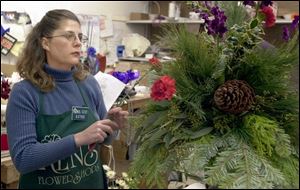
Centerpieces of greenery make the holiday glow
12/18/2002With the Holy holiday in full swing, many people have decked their halls with garland, glitter and greenery. Don't forgety our holiday table.
Ken Cappelletty, owner of en's Flower Shops, says you can make a fragrant, long-lasting centerpiece without flowers.
An arrangement using only greens may sound boring, but not when it comes to conifers. Conifers grow pointy , thin leaves called needles. Most conifers keep their needles all year long, and that's why they are called evergreens.

Kathie VanNess creates an arrangement using a variety of greenery.
For centuries people have adorned their homes with evergreens. Many thought it would protect their homes, and according to superstition, this practice would also bring the vegetation back in the spring.
The Utah Nature Society has a clever way to identify the different types of evergreens.
MANY GREENS TO CHOOSE FROM
“Three to four different greens make an interesting arrangement,” Mr. Cappelletty says. “Use combinations like silver fur, Port Orford cedar, white pine, boxwood, and seeded eucalyptus.
White pine is one of the most popular holiday greens. Its skinny, fragrant needles are light blue-green. It gets its name from the soft needles that have a white underside.
Silver fur has fragrant, dark-green needles that are silvery white on the underside.
Port Orford cedar has tiny scale-like leaves in a flat spray like other types of cedar. Western red cedar is also called the giant arborvitae because of its flat, lacy shape.
Douglas fir has flat, yellowish-green needles. This is another holiday favorite that has good needle retention. Berried Juniper has a different look because the needles are blue-green. Another bonus is the silvery-blue berries it grows.
Ponderosa pine tips have tufts off long, thin needles with plump pinecones attached.
Highland hemlock is different in appearance. It's dark-green foliage has a delicate look because the needles are soft and mall.
EVERGREEN SHOWOFFS
Other textures will add interest to your arrangement. Mr. Cappelletty recommends using some ornamental elements.
The flat, glossy holly leaf has special meaning at this season. You can find some variegated varieties. Long ago, people considered it a symbol of immortality because this broadleaf evergreen bush keeps its berries through the winter.
Some thought that if you planted a holly bush near your home, it would repel evil spirits. Some thought wearing a wreath of holly was magical. Wearing it to church on Christmas Eve would let you see into the future.
Boxwood is another popular green filler with a different texture. This broadleaf evergreen has small, round leaves.
Another common broadleaf evergreen found in arrangements year round is eucalyptus. Its flat leaves have a strong, distinctive aroma.
PUT IT TOGETHER
Once you gather your favorite greens and showoffs, it is time to put the arrangement together.
Greens can be arranged in water-soaked floral foam that has been tucked securely into a container. “They also look great in a vase,” Mr. Cappelletty says.
To hold the greens in place, stretch extra-sticky floral tape across the mouth of the container in a tic-tac-toe pattern. The tape will help hold the boughs upright.
You also can fill the vase with fruit, pebbles, glass marbles, and coins to anchor the stems in place. Just as with cut flowers, give the greens a fresh cut on the bottom of the stem before submerging them in fresh water.
Keep the water level up in your arrangement and change it every three to four days, Mr. Cappelletty says.
“An evergreen arrangement may cost as much as an arrangement with flowers, he says, “but they will last a lot longer.”
Don't forget to hide a sprig of mistletoe to add a bit of romance to your holiday.
More on mistletoe next week.